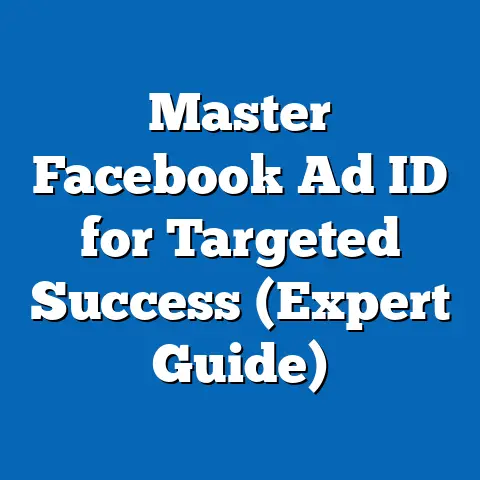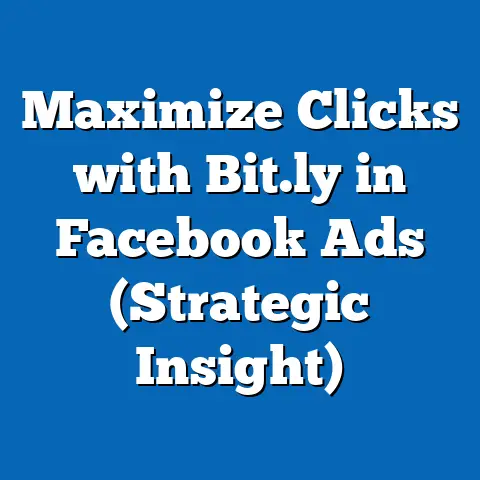Turn Scam Facebook Ads into Success Stories (Proven Strategies)
The rise of smart homes has been nothing short of revolutionary. We’ve gone from flicking light switches and manually adjusting thermostats to controlling entire ecosystems with our voices and smartphones. From smart lighting that mimics natural sunlight to security systems that learn our routines, these technologies have woven themselves into the fabric of our daily lives. I remember the first time I saw a smart thermostat in action – it felt like stepping into the future! The convenience and efficiency these products offer have fueled a massive surge in demand, making the smart home market a lucrative space for businesses.
However, this boom has also attracted a darker element: scams. I’ve seen firsthand how deceptive Facebook ads, promising unbelievable deals and revolutionary features, have flooded the platform, preying on unsuspecting consumers. These ads often feature flashy visuals, exaggerated claims, and prices that seem too good to be true. The result? Disappointed customers, damaged trust, and a lingering skepticism that affects even legitimate businesses trying to market their innovative smart home solutions.
The pervasive nature of these scams not only hurts consumers financially and emotionally, but it also creates a challenging environment for honest companies. Building trust in this climate requires more than just offering a great product; it demands a strategic approach that combats the negative perceptions fostered by deceptive advertising.
That’s why I’ve created this guide. My aim is to equip you with proven strategies for turning scam Facebook ads and their associated negative perceptions into success stories. I want to help you, whether you’re a small startup or an established brand, navigate the complex landscape of Facebook advertising and build a thriving business rooted in authenticity, transparency, and genuine value. We’ll explore the dynamics of Facebook ads, identify common pitfalls, and, most importantly, provide actionable steps to transform your advertising from a potential scam into a resounding success. Let’s dive in!
Understanding the Landscape of Facebook Ads
Facebook advertising is a powerful tool. It allows you to target potential customers with incredible precision. I’ve used it to reach very specific demographics, interests, and even behaviors. Think about it: you can show your smart home security system ad only to homeowners in a particular zip code who have expressed interest in home security, or to families with young children who might be interested in smart baby monitors. This level of granularity is what makes Facebook ads so effective when used correctly.
However, this power also makes Facebook a breeding ground for scams. Scam advertisers leverage the platform’s targeting capabilities to reach vulnerable audiences with deceptive promises. They often use eye-catching visuals – think sleek renderings of futuristic homes or dramatic videos showcasing “revolutionary” features – combined with compelling (but false) claims. The pricing is almost always unbelievable, designed to lure in customers with deals that simply can’t be real.
From my experience, a few characteristics consistently appear in scam ads, especially those in the smart home niche:
- Overly sensational claims: Promises of “effortless” installation, “unbreakable” security, or “unlimited” energy savings are red flags.
- Lack of detailed information: Vague product descriptions and missing specifications are common.
- Pressure tactics: Phrases like “limited-time offer” or “act now before it’s too late” are used to rush potential customers into making a purchase.
- Poor website design: Scam ads often link to unprofessional websites with low-quality images and grammatical errors.
- Missing contact information: Legitimate businesses make it easy to contact them. Scam ads often hide contact details or provide only a generic email address.
According to recent statistics, a significant percentage of consumers have encountered scam ads on Facebook. A 2023 survey by the Better Business Bureau found that nearly 25% of respondents reported being targeted by a scam ad on social media, with a substantial portion of those scams involving home improvement and technology products. This has led to a growing sense of distrust among consumers, making them more wary of online advertising in general.
It’s crucial to understand that distinguishing between genuine advertising and scams is not just about protecting consumers; it’s about fostering a healthy and sustainable advertising environment. When scams thrive, they erode trust in the entire platform, making it harder for legitimate businesses to reach their target audience.
Takeaway: Facebook advertising offers incredible potential, but it’s essential to be aware of the prevalent scams, understand their characteristics, and actively work to differentiate your legitimate business from these deceptive practices.
Identifying Common Pitfalls in Facebook Ads
Before we dive into strategies for success, let’s examine some common pitfalls that can inadvertently lead to your ads being perceived as scams, even if you have the best intentions. I’ve seen many businesses fall into these traps, often due to a lack of awareness or a misguided attempt to stand out from the crowd.
Here are some of the most frequent pitfalls:
-
Lack of Transparency: This is perhaps the biggest red flag for consumers. If your ads don’t clearly state the product’s features, specifications, warranty information, and return policy, you’re immediately raising suspicion. I always make sure my ads link directly to a product page with all the necessary details.
-
Exaggerated Claims: While it’s tempting to highlight the best aspects of your smart home product, avoid making claims that are unrealistic or difficult to substantiate. For example, saying your smart thermostat will “cut your energy bill in half” without any supporting data is a recipe for disaster.
-
Poor Branding: A poorly designed logo, a generic website, and inconsistent branding across your ads and website can make your business look unprofessional and untrustworthy. I always advise investing in professional branding to establish credibility.
-
Inadequate Customer Support: If customers can’t easily contact you with questions or concerns, they’re likely to assume the worst. Make sure your ads clearly display your contact information and that you have a system in place to respond to inquiries promptly.
-
Unrealistic Pricing: Offering prices that are drastically lower than the competition can raise red flags. Consumers are often wary of deals that seem too good to be true, assuming there’s a catch.
-
Using Clickbait Tactics: While clickbait headlines and visuals might attract attention, they can also damage your credibility if they don’t deliver on their promise. I always prefer to use straightforward and informative headlines that accurately reflect the content of my ads.
-
Ignoring User Feedback: Failing to respond to negative comments or reviews can create a perception that you don’t care about your customers. Actively engage with your audience, address their concerns, and show that you’re committed to providing excellent service.
Lack of Transparency: This is perhaps the biggest red flag for consumers. If your ads don’t clearly state the product’s features, specifications, warranty information, and return policy, you’re immediately raising suspicion. I always make sure my ads link directly to a product page with all the necessary details.
Exaggerated Claims: While it’s tempting to highlight the best aspects of your smart home product, avoid making claims that are unrealistic or difficult to substantiate. For example, saying your smart thermostat will “cut your energy bill in half” without any supporting data is a recipe for disaster.
Poor Branding: A poorly designed logo, a generic website, and inconsistent branding across your ads and website can make your business look unprofessional and untrustworthy. I always advise investing in professional branding to establish credibility.
Inadequate Customer Support: If customers can’t easily contact you with questions or concerns, they’re likely to assume the worst. Make sure your ads clearly display your contact information and that you have a system in place to respond to inquiries promptly.
Unrealistic Pricing: Offering prices that are drastically lower than the competition can raise red flags. Consumers are often wary of deals that seem too good to be true, assuming there’s a catch.
Using Clickbait Tactics: While clickbait headlines and visuals might attract attention, they can also damage your credibility if they don’t deliver on their promise. I always prefer to use straightforward and informative headlines that accurately reflect the content of my ads.
Ignoring User Feedback: Failing to respond to negative comments or reviews can create a perception that you don’t care about your customers. Actively engage with your audience, address their concerns, and show that you’re committed to providing excellent service.
I remember one particular example of a smart home security company whose ads were perceived as scams, even though they offered a legitimate product. Their ads featured dramatic videos of burglars being thwarted by their system, but the videos were clearly staged and over-the-top. The company also failed to provide clear pricing information and didn’t respond to negative comments on their ads. As a result, their ads were flooded with negative feedback, and their sales plummeted.
It’s also important to understand the psychological triggers that scammers often use to manipulate consumers. These include:
- Scarcity: Creating a sense of urgency by claiming limited availability.
- Authority: Implying endorsements from experts or celebrities.
- Social Proof: Falsely claiming widespread popularity or positive reviews.
- Fear of Missing Out (FOMO): Highlighting potential losses or missed opportunities.
By being aware of these tactics, you can avoid inadvertently using them in your own ads and ensure that your messaging is ethical and transparent.
Takeaway: Avoiding these common pitfalls is crucial for building trust and ensuring that your Facebook ads are perceived as legitimate and valuable.
Proven Strategies to Transform Scam Ads into Success Stories
Now, let’s get to the heart of the matter: how to transform the negative perceptions associated with scam ads into genuine success stories for your smart home business. I’ve compiled five proven strategies that, when implemented effectively, can help you build trust, attract customers, and achieve your advertising goals.
Strategy 1: Establish Authenticity and Trust
In a world saturated with fake news and deceptive advertising, authenticity is your most valuable asset. Consumers are increasingly skeptical and demanding transparency. To build trust, you need to demonstrate that your business is genuine, reliable, and committed to providing real value.
-
Showcase Genuine Customer Testimonials and Case Studies: Nothing speaks louder than the voices of satisfied customers. Collect testimonials from real people who have benefited from your smart home products. Video testimonials are particularly effective, as they add a personal touch and make the testimonials feel more authentic. Case studies can showcase how your products have solved specific problems for customers, providing tangible evidence of their value. I’ve found that including photos or videos of the customers in their smart homes adds another layer of credibility.
-
Create Transparent Ad Campaigns: Clearly communicate the features, benefits, and limitations of your smart home products in your ads. Avoid making exaggerated claims or using vague language. Be upfront about pricing, warranty information, and return policies. Link your ads directly to product pages on your website that provide detailed information and answer common questions. I always recommend including a prominent “Contact Us” button on your website and making it easy for customers to reach you with questions or concerns.
-
Highlight Your Company’s Values and Mission: Consumers are increasingly interested in supporting businesses that align with their values. Share your company’s story, highlighting your commitment to quality, innovation, and customer satisfaction. Emphasize any ethical or sustainable practices you follow. I’ve seen businesses successfully use their ads to promote their commitment to environmental responsibility or their support for local communities.
-
Get Verified on Facebook: Facebook offers a verification badge for businesses that meet certain criteria. Getting verified can help you stand out from the crowd and demonstrate that your business is legitimate. The process involves providing documentation to prove your business’s identity and legitimacy.
Showcase Genuine Customer Testimonials and Case Studies: Nothing speaks louder than the voices of satisfied customers. Collect testimonials from real people who have benefited from your smart home products. Video testimonials are particularly effective, as they add a personal touch and make the testimonials feel more authentic. Case studies can showcase how your products have solved specific problems for customers, providing tangible evidence of their value. I’ve found that including photos or videos of the customers in their smart homes adds another layer of credibility.
Create Transparent Ad Campaigns: Clearly communicate the features, benefits, and limitations of your smart home products in your ads. Avoid making exaggerated claims or using vague language. Be upfront about pricing, warranty information, and return policies. Link your ads directly to product pages on your website that provide detailed information and answer common questions. I always recommend including a prominent “Contact Us” button on your website and making it easy for customers to reach you with questions or concerns.
Highlight Your Company’s Values and Mission: Consumers are increasingly interested in supporting businesses that align with their values. Share your company’s story, highlighting your commitment to quality, innovation, and customer satisfaction. Emphasize any ethical or sustainable practices you follow. I’ve seen businesses successfully use their ads to promote their commitment to environmental responsibility or their support for local communities.
Get Verified on Facebook: Facebook offers a verification badge for businesses that meet certain criteria. Getting verified can help you stand out from the crowd and demonstrate that your business is legitimate. The process involves providing documentation to prove your business’s identity and legitimacy.
Strategy 2: Engaging Visual Content and Messaging
Your ads need to capture attention and convey your message effectively. However, it’s crucial to do so in a way that is authentic and avoids the manipulative tactics often used in scam ads.
-
Design Visually Appealing Ads: Use high-quality images and videos that showcase your smart home products in action. Focus on demonstrating their functionality and benefits in a clear and engaging way. Avoid using stock photos or generic graphics. I always recommend hiring a professional photographer or videographer to create visually stunning content that accurately represents your products.
-
Craft Compelling Ad Copy: Write ad copy that resonates with your target audience and speaks to their needs and desires. Highlight the unique benefits of your smart home products and explain how they can improve their lives. Avoid using gimmicks or clickbait tactics. Instead, focus on providing valuable information and building a connection with your audience. I’ve found that asking questions in your ad copy can be a great way to engage readers and encourage them to learn more.
-
Use Video Ads to Tell a Story: Video ads are a powerful way to showcase your smart home products and connect with your audience on an emotional level. Create videos that tell a story about how your products can solve problems, improve lives, or enhance the overall smart home experience. I always recommend including a clear call to action in your video ads, telling viewers what you want them to do next (e.g., “Visit our website,” “Learn More,” “Shop Now”).
-
Showcase Real People Using Your Products: Instead of relying on staged scenarios or actors, feature real customers using your smart home products in their everyday lives. This can help build trust and make your ads feel more relatable.
Design Visually Appealing Ads: Use high-quality images and videos that showcase your smart home products in action. Focus on demonstrating their functionality and benefits in a clear and engaging way. Avoid using stock photos or generic graphics. I always recommend hiring a professional photographer or videographer to create visually stunning content that accurately represents your products.
Craft Compelling Ad Copy: Write ad copy that resonates with your target audience and speaks to their needs and desires. Highlight the unique benefits of your smart home products and explain how they can improve their lives. Avoid using gimmicks or clickbait tactics. Instead, focus on providing valuable information and building a connection with your audience. I’ve found that asking questions in your ad copy can be a great way to engage readers and encourage them to learn more.
Use Video Ads to Tell a Story: Video ads are a powerful way to showcase your smart home products and connect with your audience on an emotional level. Create videos that tell a story about how your products can solve problems, improve lives, or enhance the overall smart home experience. I always recommend including a clear call to action in your video ads, telling viewers what you want them to do next (e.g., “Visit our website,” “Learn More,” “Shop Now”).
Showcase Real People Using Your Products: Instead of relying on staged scenarios or actors, feature real customers using your smart home products in their everyday lives. This can help build trust and make your ads feel more relatable.
Strategy 3: Targeting the Right Audience
Reaching the right audience is crucial for the success of your Facebook ad campaigns. By targeting potential buyers who are genuinely interested in smart home products, you can avoid wasting your budget on people who are likely to be skeptical or uninterested.
-
Refine Audience Targeting: Facebook offers a wide range of targeting options, allowing you to reach specific demographics, interests, and behaviors. Use these options to narrow down your audience and reach people who are most likely to be interested in your smart home products. I always recommend starting with a broad audience and then gradually refining your targeting based on the performance of your ads.
-
Use Lookalike Audiences: Facebook’s Lookalike Audiences feature allows you to create new audiences that are similar to your existing customers or website visitors. This can be a great way to reach new potential customers who are likely to be interested in your products. I’ve found that Lookalike Audiences based on my best customers tend to perform particularly well.
-
Exclude Sceptical Audiences: Consider excluding audiences who may be skeptical of smart home products or who have been targeted by scam ads in the past. This can help you avoid wasting your budget on people who are unlikely to convert. You can exclude audiences based on their interests, behaviors, or demographics.
-
Test Different Targeting Options: Don’t be afraid to experiment with different targeting options to see what works best for your smart home products. A/B testing different audiences can help you identify the most effective targeting strategies.
Refine Audience Targeting: Facebook offers a wide range of targeting options, allowing you to reach specific demographics, interests, and behaviors. Use these options to narrow down your audience and reach people who are most likely to be interested in your smart home products. I always recommend starting with a broad audience and then gradually refining your targeting based on the performance of your ads.
Use Lookalike Audiences: Facebook’s Lookalike Audiences feature allows you to create new audiences that are similar to your existing customers or website visitors. This can be a great way to reach new potential customers who are likely to be interested in your products. I’ve found that Lookalike Audiences based on my best customers tend to perform particularly well.
Exclude Sceptical Audiences: Consider excluding audiences who may be skeptical of smart home products or who have been targeted by scam ads in the past. This can help you avoid wasting your budget on people who are unlikely to convert. You can exclude audiences based on their interests, behaviors, or demographics.
Test Different Targeting Options: Don’t be afraid to experiment with different targeting options to see what works best for your smart home products. A/B testing different audiences can help you identify the most effective targeting strategies.
Strategy 4: Leveraging Social Proof and Influencer Marketing
Social proof is a powerful psychological phenomenon that can influence people’s purchasing decisions. When people see that others are using and enjoying a product, they’re more likely to trust it and want to try it themselves.
-
Encourage Reviews and Ratings: Make it easy for customers to leave reviews and ratings for your smart home products on Facebook and other platforms. Positive reviews can significantly boost your credibility and attract new customers. I always respond to reviews, both positive and negative, to show that I care about my customers’ feedback.
-
Showcase Customer Testimonials: Feature customer testimonials prominently on your website and in your ads. Use video testimonials whenever possible to add a personal touch and make the testimonials feel more authentic.
-
Partner with Micro-Influencers: Micro-influencers are social media users with a smaller but highly engaged audience. Partnering with micro-influencers who are passionate about smart home technology can be a great way to reach a targeted audience and build trust. I always research potential influencers carefully to ensure that they align with my brand values and have a genuine interest in my products.
-
Run Contests and Giveaways: Contests and giveaways can generate excitement and engagement around your smart home products. Encourage participants to share their experiences with your products or tag friends who might be interested.
Encourage Reviews and Ratings: Make it easy for customers to leave reviews and ratings for your smart home products on Facebook and other platforms. Positive reviews can significantly boost your credibility and attract new customers. I always respond to reviews, both positive and negative, to show that I care about my customers’ feedback.
Showcase Customer Testimonials: Feature customer testimonials prominently on your website and in your ads. Use video testimonials whenever possible to add a personal touch and make the testimonials feel more authentic.
Partner with Micro-Influencers: Micro-influencers are social media users with a smaller but highly engaged audience. Partnering with micro-influencers who are passionate about smart home technology can be a great way to reach a targeted audience and build trust. I always research potential influencers carefully to ensure that they align with my brand values and have a genuine interest in my products.
Run Contests and Giveaways: Contests and giveaways can generate excitement and engagement around your smart home products. Encourage participants to share their experiences with your products or tag friends who might be interested.
Strategy 5: Providing Exceptional Customer Support
Exceptional customer support is essential for building trust and differentiating your brand from scammy competitors. By providing prompt, helpful, and personalized support, you can demonstrate that you care about your customers and are committed to their satisfaction.
-
Create Responsive Support Systems: Make it easy for customers to contact you with questions or concerns. Offer multiple support channels, such as email, phone, live chat, and social media. I always respond to inquiries promptly and provide helpful and informative answers.
-
Develop a Comprehensive FAQ: Create a comprehensive FAQ that answers common questions about your smart home products, installation, troubleshooting, and warranty information. This can help customers find answers to their questions quickly and easily.
-
Use Chatbots: Chatbots can provide instant answers to common questions and help customers navigate your website. They can also be used to collect customer feedback and provide personalized recommendations. I’ve found that chatbots can significantly improve customer satisfaction and reduce the workload on my support team.
-
Engage on Social Media: Actively engage with your audience on social media. Respond to comments, answer questions, and address concerns promptly. Use social media to share helpful tips, product updates, and company news. I always monitor my social media channels closely and respond to any negative feedback or complaints as quickly as possible.
Create Responsive Support Systems: Make it easy for customers to contact you with questions or concerns. Offer multiple support channels, such as email, phone, live chat, and social media. I always respond to inquiries promptly and provide helpful and informative answers.
Develop a Comprehensive FAQ: Create a comprehensive FAQ that answers common questions about your smart home products, installation, troubleshooting, and warranty information. This can help customers find answers to their questions quickly and easily.
Use Chatbots: Chatbots can provide instant answers to common questions and help customers navigate your website. They can also be used to collect customer feedback and provide personalized recommendations. I’ve found that chatbots can significantly improve customer satisfaction and reduce the workload on my support team.
Engage on Social Media: Actively engage with your audience on social media. Respond to comments, answer questions, and address concerns promptly. Use social media to share helpful tips, product updates, and company news. I always monitor my social media channels closely and respond to any negative feedback or complaints as quickly as possible.
Takeaway: By implementing these five strategies, you can transform the negative perceptions associated with scam ads into genuine success stories for your smart home business. Remember, authenticity, transparency, and exceptional customer support are key to building trust and attracting loyal customers.
Case Studies of Success
Let’s look at some real-world examples of businesses in the smart home niche that successfully turned their Facebook ad campaigns around after initial struggles or negative feedback.
Case Study 1: Smart Lighting Solutions
This company initially faced challenges due to ads that focused heavily on technical specifications, which confused potential customers. They also received negative feedback about their installation process.
-
The Transformation: They shifted their focus to showcasing the emotional benefits of their smart lighting system, highlighting how it could create a more relaxing and enjoyable home environment. They also created a series of video tutorials demonstrating the ease of installation.
-
The Results: Their ad engagement increased by 40%, and their customer satisfaction ratings improved significantly. They attributed their success to focusing on the customer experience and providing clear, helpful information.
The Transformation: They shifted their focus to showcasing the emotional benefits of their smart lighting system, highlighting how it could create a more relaxing and enjoyable home environment. They also created a series of video tutorials demonstrating the ease of installation.
The Results: Their ad engagement increased by 40%, and their customer satisfaction ratings improved significantly. They attributed their success to focusing on the customer experience and providing clear, helpful information.
Case Study 2: Smart Home Security System
This company’s initial ads were perceived as alarmist and fear-mongering, featuring dramatic depictions of home invasions. This approach alienated potential customers and led to negative feedback.
-
The Transformation: They rebranded their ads to focus on the peace of mind and security their system provided, showcasing families feeling safe and protected in their homes. They also offered a free consultation service to help customers choose the right system for their needs.
-
The Results: Their conversion rates increased by 25%, and their brand perception shifted from being seen as fear-mongering to being seen as trustworthy and reliable.
The Transformation: They rebranded their ads to focus on the peace of mind and security their system provided, showcasing families feeling safe and protected in their homes. They also offered a free consultation service to help customers choose the right system for their needs.
The Results: Their conversion rates increased by 25%, and their brand perception shifted from being seen as fear-mongering to being seen as trustworthy and reliable.
Case Study 3: Smart Thermostat Company
This company’s initial ads focused on energy savings, but they lacked concrete data to support their claims. This led to skepticism and low conversion rates.
-
The Transformation: They partnered with a third-party research firm to conduct an independent study on the energy savings provided by their thermostat. They then used the data from the study in their ads, providing concrete evidence to support their claims.
The Transformation: They partnered with a third-party research firm to conduct an independent study on the energy savings provided by their thermostat. They then used the data from the study in their ads, providing concrete evidence to support their claims.
Takeaway: These case studies demonstrate that it’s possible to overcome negative perceptions and turn your Facebook ad campaigns into success stories by focusing on authenticity, transparency, and customer satisfaction.
Conclusion
Navigating the landscape of Facebook advertising in the smart home niche can be challenging, especially given the prevalence of scam ads and the resulting consumer skepticism. However, I hope this guide has shown you that success is achievable with the right strategies.
The key takeaways are:
- Authenticity is Paramount: Build a credible brand image by showcasing genuine customer testimonials, creating transparent ad campaigns, and highlighting your company’s values.
- Engaging Content Matters: Design visually appealing ads that capture attention while remaining authentic. Craft compelling ad copy that resonates with your target audience without resorting to gimmicks.
- Target the Right Audience: Refine your audience targeting to reach potential buyers who are genuinely interested in smart home products.
- Leverage Social Proof: Encourage reviews and ratings, showcase customer testimonials, and partner with micro-influencers to build trust.
- Provide Exceptional Support: Offer robust customer support and differentiate your brand from scammy competitors.
I encourage you to view the challenges posed by scam ads as opportunities to innovate and differentiate your brand. By focusing on authenticity, transparency, and customer engagement, you can build a thriving business that earns the trust and loyalty of your customers.
The future of Facebook advertising in the smart home niche is bright. As technology continues to evolve and consumers become more sophisticated, there will be even greater opportunities for businesses to connect with their target audience and deliver valuable products and services. By embracing the strategies outlined in this guide, you can position your business for long-term success.
Call to Action
I’d love to hear about your experiences with Facebook ads, whether you’ve encountered scams or successfully navigated the landscape. What strategies have worked for you in turning your ad campaigns into success stories? Share your thoughts and insights in the comments below! Let’s learn from each other and build a community of ethical and effective Facebook advertisers in the smart home niche.






